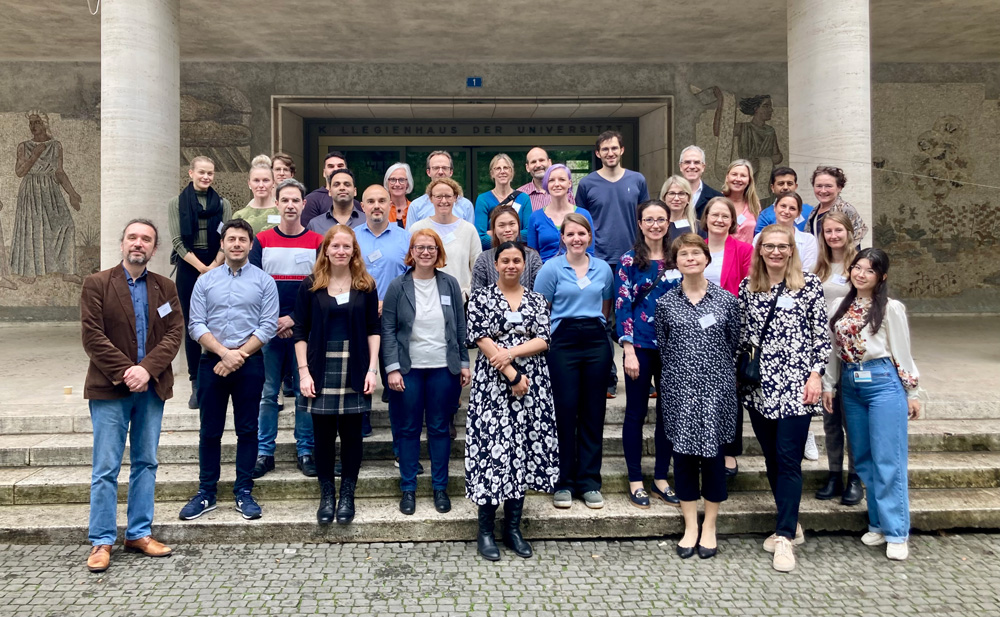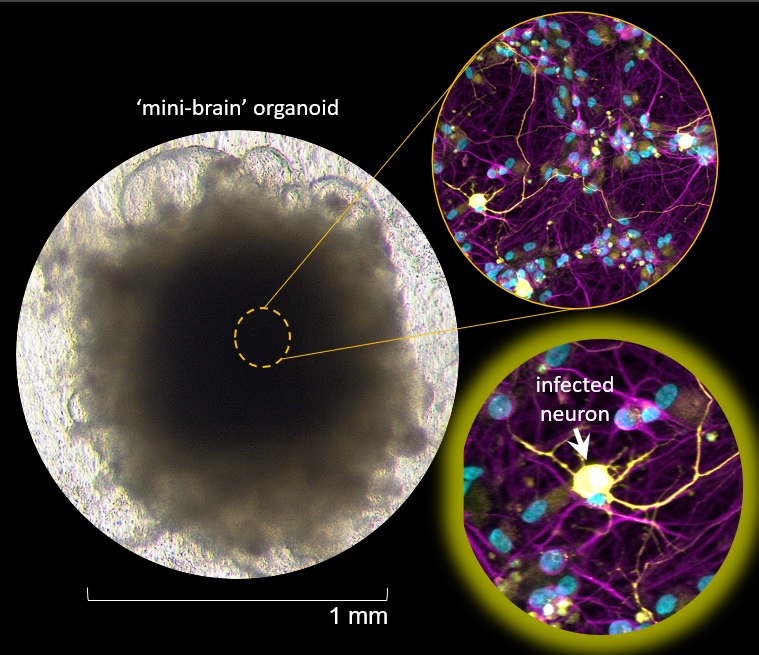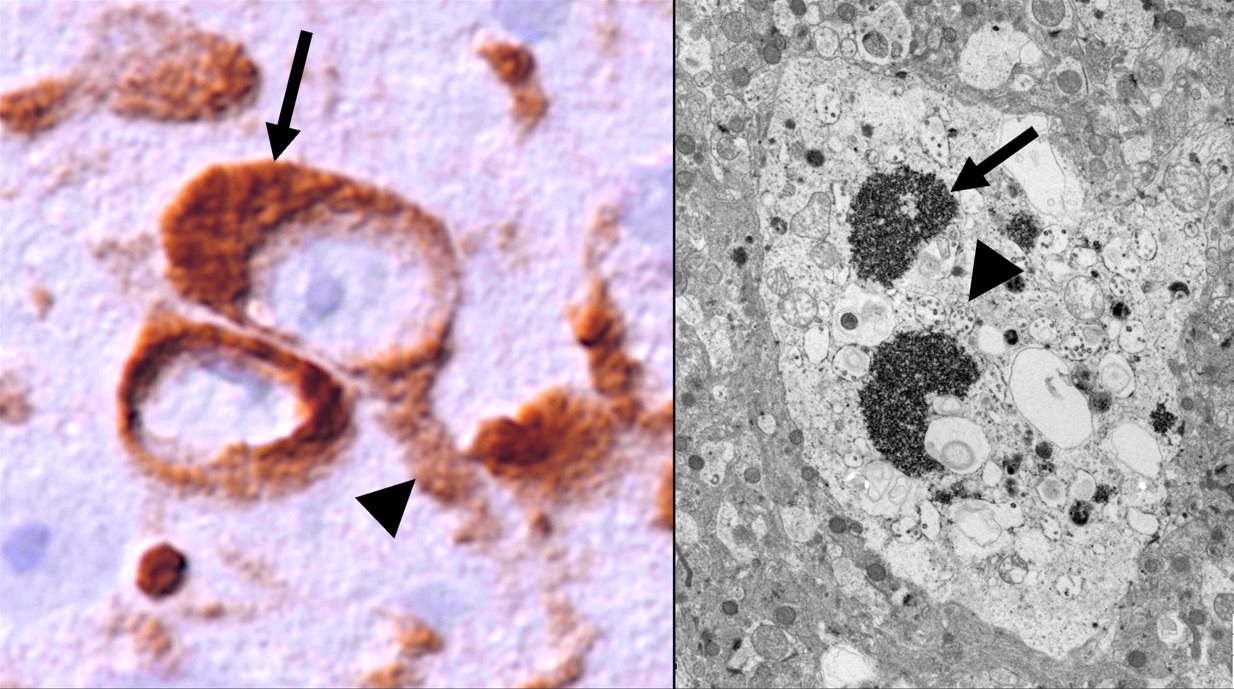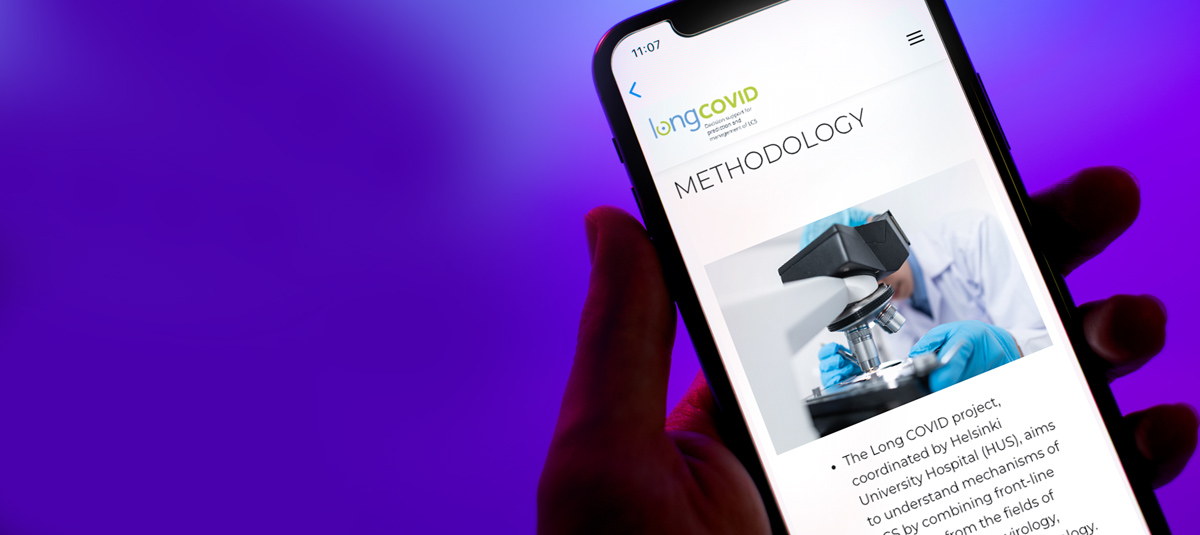|
NEWSLETTER N°2 / November 2023
|
|
|
|
|
|
Welcome to the
2nd Long COVID Newsletter!
The 4-year Long COVID project, led by HUS Helsinki University Hospital, just reached month 18 of its lifetime. The consortium, including partners from six countries (Finland, Germany, Italy, Netherlands, Switzerland and Estonia) works together through nine interconnected work packages (WPs) to elucidate the predisposing factors and mechanisms for the development of Long Covid Syndrome (LCS). This is essential to provide adequate treatment and care to the Long COVID patients.
|
|
This 2nd Newsletter provides an overview of the main progress on the project’s updates for the past six months and the following steps.
|
|

|
|
|
|
|
Long COVID cohorts
|
|
In WP1 (“LCS cohorts and guidelines”), to decipher the mechanisms underlying LCS, the Long COVID project is conducting geographically diverse cohort and registry studies in Finland, the Netherlands and Switzerland. Further information about the cohorts is available in our first newsletter.
|
|
|
|
The recruitment of Long COVID and control patients and the collection of their clinical samples for bioanalyses is proceeding well. The Dutch cohort achieved their goal of 300 biosamples of the Long COVID patients’ cases and 500 biosamples of the controls. In Finland, due to diminishing numbers of Long COVID patients remitted to the policlinic and the fact that many earlier patients have recovered well and no longer are suitable to give samples, HUS cut half its target numbers to 160 Long COVID cases and 160 controls. So far, HUS achieved around 90% of its target. The Swiss cohort achieved 25% of its target of 120 Long COVID cases.
|
Studies carried out by HUS in Finland
|
1. A cardiopulmonary exercise test (clinical study) was done for 101 HUS Long COVID patients, being the majority (86%) home treated during their acute COVID-19 infection. It was found that the cardiopulmonary exercise capacity was normal with increased sympathetic activity in most patients. However, HUS identified subgroups with dysautonomia or chronotropic incompetence with a lowered exercise capacity as measured by Wlast4 or VO2max. Subjective exercise intolerance and fatigue poorly foresaw the level of exercise capacity. The results could be exploited for rehabilitation from Long COVID. These results are currently under review for future publication.
|
|
2. HUS carried out in collaboration with National Institute for Welfare and Health a register study in Finland on the incidence of Long COVID based on ICD-10 diagnosis codes (U08 and U09) during 2019-2021. This register study also followed diagnostic codes that could be linked to post Covid-19 in this register which covers all citizens of Finland. The results will soon be submitted for peer review.
|
3. HUS also studies the rehabilitation of post Covid-19 in a randomized controlled trial, the AIR trial. This study compares a digital net therapy developed at HUS to a mindfulness-based program and a control group, which receives treatment as usual. The Randomized controlled clinical trials has progressed without major challenges and 189 patients have been randomized of the target of 360.
|
|

|
|
|
|
|
|
Mechanistics and
pathogenic studies
|
|
|
|
|
WP2 employs different techniques such as virology, serology, platelet and coagulation activity, immunophenotyping and microbiome research to find indicators of possible mechanisms behind LCS. In the second half of 2023, the WP2 led by UH addressed 7 specific questions:
|
|
Question 1) Now that WP2 demonstrated that human neurons can be infected (Kettunen et al., Journal of Virology 2023), the aim was to discover which cellular protein is key for SARS-CoV-2 infection of human neurons.
|
|
Answer to question 1: WP2 just discovered that a cellular enzyme localized in the digestive organelles of the neurons, called lysosomes, is absolutely required for infection. Furthermore, WP2 identified a drug that inhibits the newly identified host factor and protects neurons from SARS-CoV-2. The results will be submitted for publication in early 2024.
|
|
|
|
Question 2) WP2 wanted to determine if an infected neuron produces and releases infectious progeny viruses that could potentially spread in the brain activating a neurological response.
|
|
Answer to question 2: WP2 latest results provided evidence that infected neurons are not passive bystanders but may play an active role in infection and potentially neurological diseases. These results will be submitted for publication in early 2024.
|
|
|
|
Question 3) To understand the mechanism of neuroinvasion and the consequences of infection in a novel ‘mini-brain’ model where miniaturized brains are artificially created in the laboratory starting from human stem cells and can be infected with different viruses that have neuroinvasive potential.
|
|
Answer to question 3: After successfully establishing the mini-brain system (Figure 1 below), as a collaborative effort between University of Helsinki and University of Queensland, Australia, WP2 is now testing if the new drugs identified during the last year are really able to protect not only the neurons in the mini-brain but all types of cells contained in this state-of-the-art model system of the human brain.
|
|
|
|
Question 4) Using pre-clinical models, to understand if the lung damage and symptoms caused by SARS-CoV-2 are unique to this virus or are also caused by other respiratory viruses.
|
|
Answer to question 4): The lung damage and symptoms are common to more viruses. In July, the results of an in-depth comparative study led by Prof. Anja Kipar at the University of Zurich (UZH), in collaboration with the University of Liverpool, on experimentally infected mice showed that the pulmonary vascular response exerts a stereotypic response to respiratory virus infections including SARS-CoV-2 (De Neck et al., viruses 2023).
|
|
Question 5) To understand if, in the brain of infected animals, SARS-CoV-2 infects only neurons or if other parts of the brain, including blood vessels and non-neuronal cells, can be infected.
|
|
Answer to question 5: In a systematic study on infected brains of mice challenged with SARS-CoV-2 Delta variant, Prof. Anja Kipar and her team at UZH morphologically investigated the interface between the vascular compartment and the neuroparenchyma, with and without an inflammatory reaction. The goal of the study was to determine any relation between the presence of leukocytes and the vessel, and to locate the virus in this compartment, also investigating morphological changes of the neurovascular. When present, the leukocytic infiltrate was localized in the perivascular space, with some evidence of leukocyte migration into the neuroparenchyma. In general, the presence of leukocytes was not associated with alterations of the vascular wall other than those seen in association with leukocyte extravasation. Viral particles were only observed in neurons (Figure 2 below) but not at any level of the vascular wall. These changes suggest that neither the virus nor the leukocytic infiltrate target the blood vessels. Instead, the latter represents a response to signals within the neuroparenchyma that are likely the result of the neuronal infection.
|
|
|
|
Questions 6) To discover if there are genetic risk factors for Long COVID in humans, and if there are, to understand how they work.
|
|
Answer to question 6): We discovered that mutations in a human gene called FOXB4 increase the risk of severe Long COVID. This relevant result will be published soon.
|
|
|
|
Question 7) WP2 wanted to complete the collection of human samples of the cerebrospinal fluid, blood, and gut microbiota to determine whether there are specific changes in metabolites, antibodies, and microbes in Long COVID patients compared to healthy individuals.
|
|
Answer to question 7: The results obtained in only a few months exceeded WP2 expectations. WP2 almost completed the collection of human samples which will be finalized during spring 2024. New researchers, young and senior, were recruited by the consortium, which by coordinating more than seven techniques, including metabolomics, lipidomic, and serology, is now creating a comprehensive picture of the specific changes that occur in humans affected by severe Long COVID. When these studies are completed, WP2 aims to provide a quantitative way to diagnose, classify, and potentially intervene in Long COVID.
|
|
|
|

|
|
Figure 1: Image of a mini-brain, or organoid, grown in the laboratory and imaged with a fluorescence microscope after SARS-COV-2 infection. The infected neurons are shown in yellow, the non-infected cells in magenta. The nuclei of the cells in cyan. The neuronal infection model and the mini-brain system was developed thanks to a collaboration between the research groups of Dr. Giuseppe Balistreri and Professor Jari Koistinaho at the University of Helsinki, at the teams of Dr. Merja Joensuu and Professor Ernst Wolvetang at the University of Queensland, Australia.
|
|
|
|

|
|
Figure 2: Brain, mouse, 6 days post intranasal SARS-CoV-2 infection. Left: Immunohistological image showing viral nucleoprotein expression in cytoplasm (arrow) and processes (arrowhead) of neurons. Right: Immune-electron microscopical image showing viral particles in cytoplasmic vacuoles (arrowhead) and evidence of large cytoplasmic aggregates of viral nucleoprotein (arrow). © Simon De Neck, Udo Hetzel and Anja KIpar, Laboratory for Animal Model Pathology, Vetsuisse Faculty, Institute of Veterinary Pathology, University of Zurich.
|
|
|
|
|
|
|
Data Harmonisation and Standardisation
|
Over the past 6 months, project partners were actively engaged under the coordination of NUROMEDIA (NURO, WP6 “Data Infrastructure, processing & GUI” leader) in various tasks related to data availability, data analyses and its further processing. These tasks primarily revolved around extensive discussions on the format of data used and/or generated by the project and determining the best approaches for harmonising and standardising it. Significant progress was made in defining the approach and WP6 also started mapping the parameters of the data that need to be evaluated following common standards applied by the scientific and clinical communities.
|
|
In the next months, WP6 will further refine the process of harmonising and standardising the available data, also adding more variables. This includes ensuring consistency in data formats, terminology and quality control measures.
|
|
|
|
Long COVID infographics
|
|
Another key activity undertaken in WP6 during the last months was the definition of the content for infographics focusing on the mechanisms to manage Long Covid. NURO worked on creating mock-ups and drafts for leaflets, ensuring that they effectively convey the necessary information. Additionally, NURO also focused on selecting interactive tools that allow users to pinpoint specific areas of attention and identify the most appropriate management mechanisms. The tool will further be evaluated and customised to best meet the needs of the stakeholders bringing added value to both clinical partners, practitioners and the patients. Consultations were conducted to ensure that the content remains accurate, up-to-date, and aligned with the latest medical advancements and practices in managing Long Covid.
|
As a next step within this task, WP6 will work on finalising the content for the infographics. This will involve incorporating feedback and suggestions from the clinical partners to ensure accuracy and relevance.
|
|
|
|
|
Ethics and privacy
|
|
Within the Long COVID project, partner Chino is the leader of WP7 “Ethics and privacy”. Chino’s activities in the last 6 months included some important tasks related to ethics and privacy.
|
For ethics, an Ethical Advisory Board was built including relevant experts. On that specific topic, Chino just elaborated Ethics guidelines for the benefit of all the Long COVID partners that can use it for their internal activities with the respective local ethical committees, helping them to demonstrate that the data are treated in an ethical and secure way into the project.
|
|
|
For privacy, during the last months, Chino collected information from the partners for the future elaboration of the Data Protection Impact Assessment (DPIA) and produced the Registry of Processing Activities (RoPA) related to the project. These are mandatory documents for privacy, in particular for each data treatment involving the health data of patients.
|
|
Currently, Chino is also monitoring artificial intelligence (AI) regulatory compliance, actually under adoption thanks to the recent EU Commission “AI Act”, to regulate AI to ensure better conditions for the development and use of this innovative technology within the project. Long COVID is using AI and will also develop and apply a machine learning and AI-informed Long Covid Prediction Support (LCPS) tool to predict and stratify the LSC patients. For that reason, it is important to verify and guarantee that the algorithms elaborate data in a trustworthy and safe modality in the framework of Long COVID.
|
|
|
|
|
|
Long COVID project website & communication material
|
|
The Long COVID website includes several functionalities and features to ensure the highest extent of accessibility for all types of relevant stakeholders. The website brings together general information about the project (e.g. concept, objectives, work packages, etc.), the latest news, publications, networking activities and communication material.
|
|
The News & Events section presents a well-updated list of posts on the project’s news and activities, but also information from external organisations, initiatives & projects dealing with Long COVID, such as relevant publications, articles, webinars, conferences or any other type of events. Do not miss this very interesting section to be updated!
|
|
|

|
|
|
Additionally, different communication materials prepared to increase the visibility of the Long COVID project are available in the Communication material section:
|
|
- Long COVID Newsletters (2)
|
- Long COVID Press Releases (3)
|
|
Steinbeis Europa Zentrum (SEZ) is the leader of the WP8 focused on communication, dissemination, networking and exploitation.
|
|
|
|
|
|
|
|
Long COVID and ORCHESTRA collaborate
|
|
ORCHESTRA is a three-year international research project aimed at tackling the coronavirus pandemic and funded by the European Union’s Horizon 2020 programme. Its vision is to establish an international large-scale cohort for the conduct of retrospective and prospective studies in order to generate rigorous evidence to improve the prevention and treatment of COVID-19 and to be better prepared for future pandemics.
|
|
The project aims to develop evidence-based recommendations for effective prevention, protection and optimized treatment of COVID-19 patients (including long-term consequences) with a special focus on ‘at risk’ populations, including healthcare workers and fragile individuals. Additional objectives are to assess impact of environmental factors, socio-economic determinants, lifestyle and confinement measures on the spread of COVID-19, to provide knowledge on the efficacy of vaccines against SARS-CoV-2, and to provide a model for responsiveness for future pandemic outbreaks.
|
|

|
ORCHESTRA was recently extended until November 2024. It is led by the University of Verona and involves 26 partners (extending to a wider network of 37 partners) from 15 countries: Argentina, Belgium, Brazil, Congo, France, Gabon, Germany, India, Italy, Luxemburg, Netherlands, Romania, Slovakia, Spain, and Venezuela.
|
|
You can find out more about its findings and latest news on the ORCHESTRA website. Its latest publication on post-COVID can be found here.
|
|
|

|
|
|
|
|
|
|
|
Project Coordinator-Support
Riikka Paasikivi
|
Communication & Dissemination leader
Francisco Javier Casado Hebrard
|
|
|
|

|
|
Funded by the European Union. Views and opinions expressed are however those of the author(s) only and do not necessarily reflect those of the European Union or the European Health and Digital Executive Agency (HaDEA). Neither the European Union nor HaDEA can be held responsible for them.
|
|
|
|
|
|
|
|
|